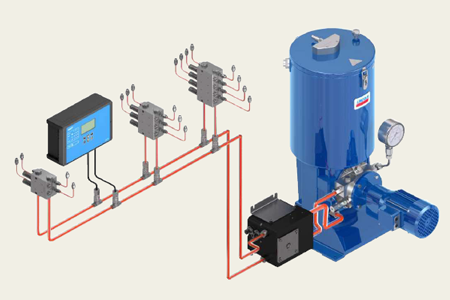Proper lubrication is crucial in industrial machinery for precision and efficiency. It ensures the smooth operation and longevity of critical components. This article will explore the ins and outs of machine lubrication.
Lubrication is crucial for machinery maintenance, affecting 40% of total maintenance costs. Lubrication programs start with mapping machine lubrication points. It includes working conditions, requirements, and criticality. This information helps select the most suitable lubricant. It determines the required quantity and calculates re-lubrication intervals.
There are 'Rs' in machine lubrication.
Right Lubricant: Precision in Selection
A successful lubrication strategy starts with selecting the right lubricant. The viscosity, base oil, and additive package need to match the particular specifications of the equipment. Viscosity ensures proper lubricant flow. The base oil and additives customize the lubricant's properties. This is to combat particular challenges like extreme temperatures, heavy loads, or contaminants. Selecting the right lubricant reduces wear and tear. It minimizes friction and improves machine performance.
Right Amount: Balancing the Equation
Achieving optimal lubrication involves a delicate balance in quantity. Too little lubricant leads to insufficient coverage, increased friction, and accelerated wear. Over-lubrication can cause overheating, waste resources, and likely harm the machinery. The precise measurements and application of lubricant ensure that the components receive protection. The application of lubricant should not be too much nor too little.
Right Time: Timing is Everything
It is true that timing is crucial in the world of machinery. Planned lubrication intervals is the foundation of preventive maintenance. Several factors determine when lubrication is necessary. These factors are machinery usage, operating conditions, and the lubricant's lifespan. Implementing a well-structured lubrication schedule prevents machinery breakdowns. It extends equipment life and minimizes unplanned downtime. Consistency in adhering to these schedules is key to sustaining optimal performance over the long term.
Right Place: Targeting the Critical Areas
Precision in lubrication extends to the strategic placement of lubrication points within machinery. It takes skill to locate the crucial lubrication locations within machinery. It ensures that the lubricant reaches the components that need it most. This is essential for maximizing the effectiveness of the lubrication process. It contributes to reduce wear, increased efficiency and improved machine reliability.
Right Manner: Executing with Expertise
The execution of the lubrication process is crucial. Applying lubricant requires skilled personnel that understands the complexities of the machinery. The use of right tools and equipment is required. They have to make sure that the lubrication procedure is done carefully and according to established protocols. The proper way of doing things reduces the possibility of mistakes. It improves lubrication effectiveness and benefits the machinery's general health.
Advantages of Automatic Bearing Lubrication
Reduced Waste and Bearing Failure Risk
The right amount of grease is supplied to each lubrication point due to a single-point automatic lubrication system. It reduce grease wastage and the risk of bearing failure. This is by adjusting re-lubrication quantities and intervals based on the working conditions and the type of bearing.
Cleanliness
Lubricant contamination can impact bearing life. It increase failure risk in manual lubrication programs. To avoid contamination, clean processes and grease fitting caps are essential. A single-point automatic lubricator provides accurate, fresh, and clean lubricant flow. It maintains proper application condition and preventing contaminant ingress. Proper installation ensures proper application and prevents contamination.

Simalube® lubricators are versatile for single-point lubricating tasks with grease or oil, and can be used with various greases and oils.
Labor Saving and Skill Application
The transition from manual to automated lubrication doesn't just save time. It optimizes the use of skilled maintenance technicians. These professionals can use their expertise in continuous improvement, lubricant analysis programs, contamination control, and leakage prevention. Automated lubrication enables the workforce to concentrate on value-added tasks. It contributes to the whole maintenance strategy.

Le Price Lincoln Dual-Line System is a good choice for large machinery exposed to harsh conditions
Environment, Health, and Safety Considerations
Beyond operational efficiency, automatic lubrication systems contribute to environmental sustainability. By minimizing grease waste, facilities reduce their ecological footprint. In restricted or hazardous locations, these systems reduce risks associated with manual lubrication activities.This ensures the safety and welfare of personnel.
Typical Problems and Solutions
The benefits of automated lubrication are important. Ignoring crucial aspects can weaken its effectiveness. Regular inspections are vital to identify installation issues and ensure optimal system performance. Selection of right lubricant is essential for achieving the system's full potential.
When to Opt for Automatic Lubrication
It's important to note that automated lubrication is not a one-size-fits-all solution. Understanding the nuances of its implementation is key to maximizing its benefits. The adoption of automated lubrication should be based on a thorough comprehension of the application's requirements. It must be compatible with the lubrication system and potential performance impact.
Beyond the 'Rs': A Holistic Approach to Maintenance
Although the 'Five Rs' are the basis of a well-oiled machine, a comprehensive maintenance plan goes beyond these guidelines. Proactive maintenance strategies must include regular machinery inspections. It also includes trend analysis and the use of condition monitoring technologies. Industries can minimize disruptions, maximize efficiency, and maximize return on machinery investments. This is by anticipating and proactively addressing potential issues.
This articles serve as your road map as we navigate the challenging landscape of machine lubrication. By embracing the 5Rs, industries can elevate their maintenance practices to new heights. Preventive maintenance becomes clear as the key to long-term operational excellence.
At CRE Philippines, we recognize the transformative impact of automated lubrication. We also provide industries with the know-how and resources necessary to realize their full potential. Our commitment extends beyond delivering cutting-edge solutions. We offer comprehensive training programs to empower your workforce.
Explore our training initiatives, such as the Machinery Lubrication Engineer Program. This program is designed to enhance the skills of your maintenance technicians. This training ensures they have the necessary skills to implement and optimize automated lubrication systems. Our training is tailored to meet the evolving needs of your maintenance strategy.
Contact us to be your partner. We'll help you navigate the complexities and embrace innovations that drives long-term success.
Source:
Sabogal, G. (2013) The Five 'Rs' of Machine Lubrication. Machinery Lubrication


